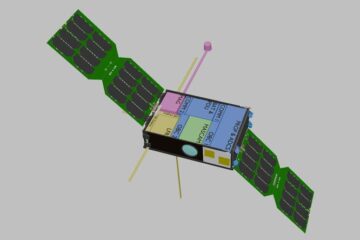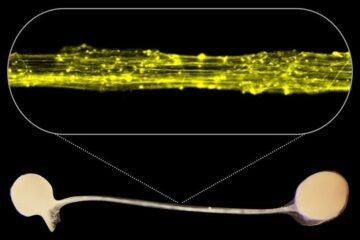How the ozone hole influences Antarctic Ice

Panoramic view of the Concordia station on the Antarctic plateau during the "sun dog" phenomenon, a peculiar solar halo occurring in polar regions.
Credit: CNR-Isp
Ozone depletion has had a direct effect on the geochemical cycle of iodine trapped in Antarctic ice.
The ozone hole doesn’t just affect the health of human, terrestrial and marine ecosystems. It also affects environmental chemical processes at the South Pole. This has been demonstrated by an international research team coordinated by the Institute of Polar Sciences of the National Research Council (CNR-Isp) and Ca’ Foscari University of Venice. They studied for the first time, the effects of ozone depletion on iodine trapped in Antarctic ice. The results of the study, which also involved researchers from the Paul Scherrer Institute (PSI, Switzerland), the Institute for Interdisciplinary Science (Icb-Conicet, Argentina), the Institute of Physical Chemistry Rocasolano (Csic, Spain), the Korean Polar Research Institute (South Korea), the National Center for Atmospheric Research (United States) and the University of Rome 3, are published in the journal Nature Communications.
In Antarctica, where the ice contains valuable information on the past of the atmosphere of our planet, researchers have extracted an about 12 meters long ice core from near the international research station Concordia. This was done with the aim of chemically analyzing the ice to discover the temporal evolution of iodine over a period of about 200 years (from 1800 to 2012). “For the first time, it was possible to observe and evaluate the effects of ultraviolet radiation on the concentration of this element in the snow,” explains Andrea Spolaor, CNR-Isp researcher and first author of this work. “Iodine plays a key role in polar atmospheric chemistry and in the radiative budget of the planet, so studying how it is exchanged between the snow and atmosphere is crucial when refining future climate and environmental projections.”
To assess and interpret the trends in iodine concentrations in the ice core, the researchers employed a multidisciplinary approach that included atmospheric and physicochemical models in addition to chemical analyses. Dr Spolaor explains that “We found nearly constant concentrations of iodine from 1800 to 1974, and then we found a sharp and significant reduction from 1975 to 2012. Our research shows that the reduction in iodine concentration and its consequent emission into the atmosphere can be attributed to the reduction in stratospheric ozone concentration, resulting in increased UV radiation reaching the Antarctic surface.”
“The implications of this discovery,” adds Carlo Barbante, director of CNR-Isp and professor at Ca’ Foscari University, “are many and have the potential to open new research horizons. We use the study of iodine in Antarctic ice cores to assess the presence of other stratospheric ozone depletion events that could have occurred in the past. This could potentially be applied to up to 1.5 million years ago, thanks to the imminent launch of the international project Beyond Epica, coordinated by Cnr-Isp and in which Ca’ Foscari University participates”.
“More than 40 years after the identification of the thinning of the stratospheric ozone layer, these results are also relevant in light of present and future environmental and climate challenges,” concludes François Burgay, co-author of the research and postdoc at the Paul Scherrer Institute. “With this work we show how humans have effects on the environment, and even when appropriately mitigated through the adoption of international protocols, that can continue for many decades with largely unknown consequences. For this reason, also in view of the upcoming COP26 in Glasgow, we must act quickly to limit the long-term effects of the climate change that is already underway. The time factor is decisive.”
Journal: Nature Communications
DOI: 10.1038/s41467-021-26109-x
Article Title: Antarctic ozone hole modifies iodine geochemistry on the Antarctic Plateau
Article Publication Date: 5-Oct-2021
Media Contact
Enrico Costa
Università Ca’ Foscari Venezia
enrico.costa@unive.it
Office: 39-041-234-8004
All latest news from the category: Earth Sciences
Earth Sciences (also referred to as Geosciences), which deals with basic issues surrounding our planet, plays a vital role in the area of energy and raw materials supply.
Earth Sciences comprises subjects such as geology, geography, geological informatics, paleontology, mineralogy, petrography, crystallography, geophysics, geodesy, glaciology, cartography, photogrammetry, meteorology and seismology, early-warning systems, earthquake research and polar research.
Newest articles

Caution, hot surface!
An international research team from the University of Jena and the Helmholtz Institute Jena are demystifying the mechanisms by which high-intensity laser pulses produce plasma on the surface of solids….

Exploring the Asteroid Apophis With Small Satellites
In five years’ time, a large asteroid will fly very close to Earth – a unique opportunity to study it. Concepts for a national German small satellite mission are being…

First model of the brain’s information highways developed
Our human brain is not only bigger and contains more neurons than the brains of other species, but it is also connected in a special pattern: Thick bundles of neurons…





















